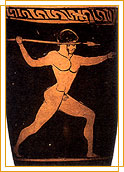Rules of javelin
The javelin athletes competed either in ekebolon (throwing the javelin farther away) or in stohastikon  (aiming at a particular target). (aiming at a particular target).
Ekebolon javelin throw
This type of javelin throw took place at the Stadium, and according to several representations on pots the athlete began his attempt from a fixed point, probably the starting line of the track, before throwing the javelin. The latter had to fall within an area defined on three sides whereas if the javelin landed outside the predetermined area, the throw was invalid. The throws were noted with a small pole.
The technique of throwing was similar to the one used by the athletes today, while the only difference was in the use of the thong. First the athlete tied the thong as tightly as possible, tried it several times, and put his index and middle finger into the loop of the thong. Before beginning the run-up, he pushed the javelin back with his left hand to tighten the thong and to grip it with his right hand. Then, while holding the javelin, the athlete turned his body in the direction of the throw and started the run-up. A few steps before throwing the javelin, he pulled his right arm back, turned his body and head to the right, crossed his right foot in front of the left and drew his left arm back so that he could turn more easily. Then, slightly bending his knees, he stretched his left leg in order to stop his movement so that he didn't cross the line. From this final position he would throw the javelin as far as he could.
Stohastikon
Throwing the javelin at a target was mostly performed on horseback. In this event, the athlete had to aim his javelin at a round target, often a shield, while riding a horse. The horse's movement affected the rider's steadiness and limited the control he had over his movements. The rider should achieve complete coordination of the horse's gallop and the movement of his hand while keeping his eyes focused on the target. The stohastikon javelin throw was one of the main events of the Panathenaic and the Heraian Games.
|
